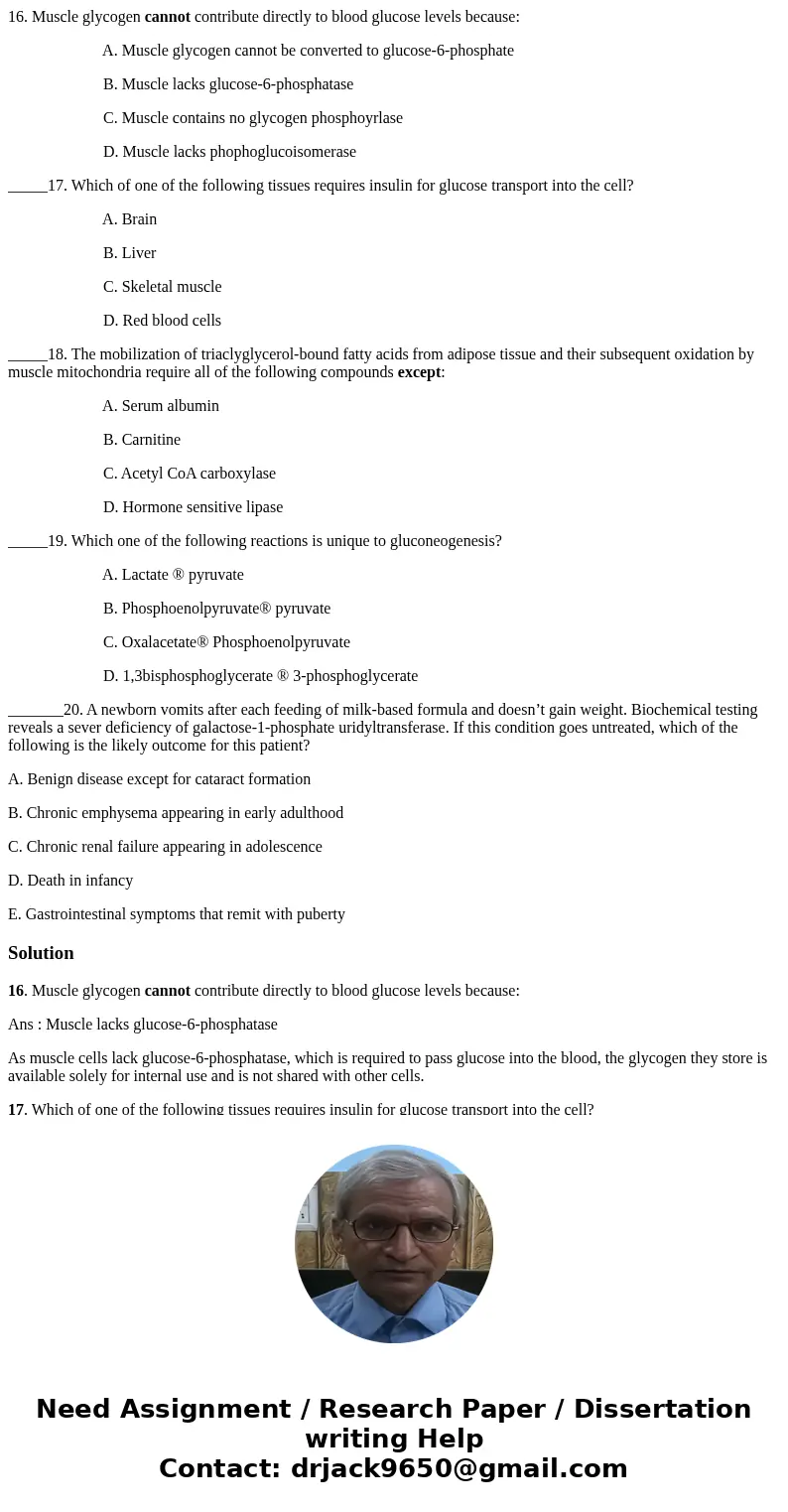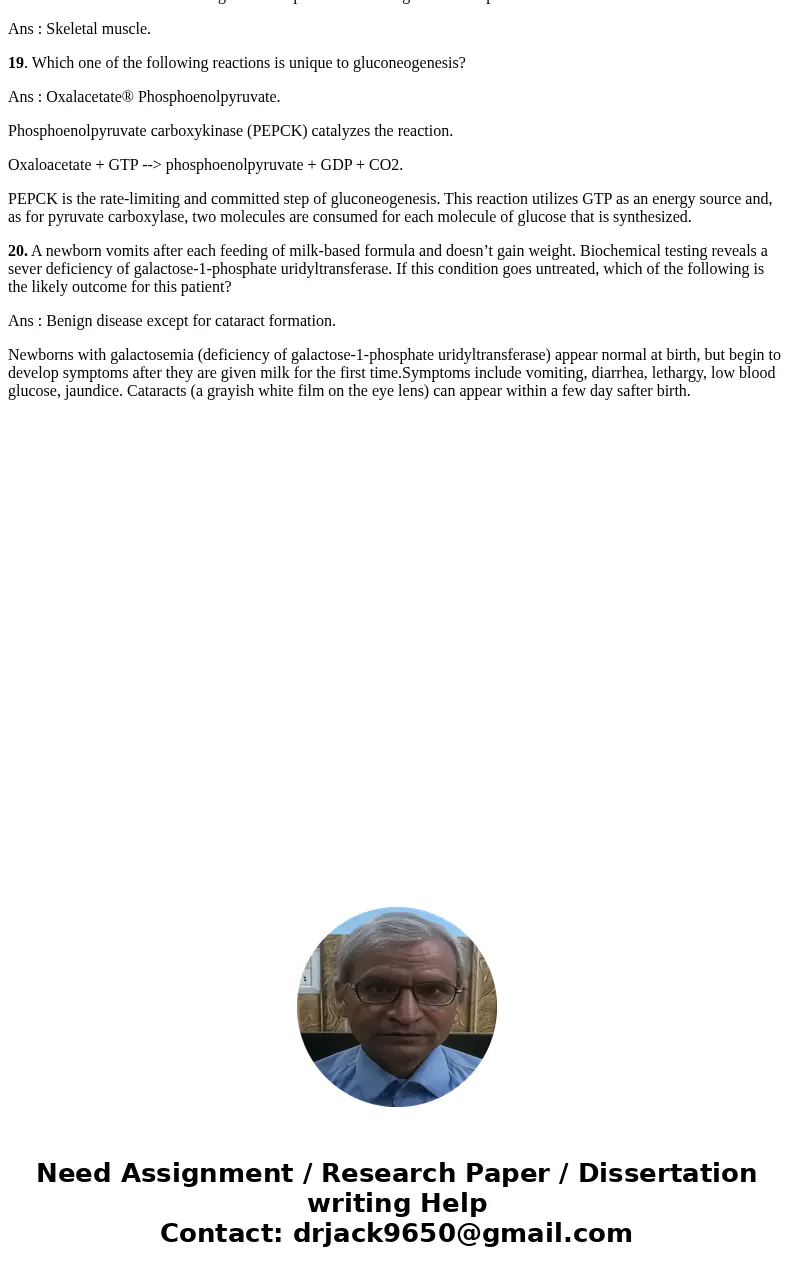16 Muscle glycogen cannot contribute directly to blood gluco
16. Muscle glycogen cannot contribute directly to blood glucose levels because:
A. Muscle glycogen cannot be converted to glucose-6-phosphate
B. Muscle lacks glucose-6-phosphatase
C. Muscle contains no glycogen phosphoyrlase
D. Muscle lacks phophoglucoisomerase
_____17. Which of one of the following tissues requires insulin for glucose transport into the cell?
A. Brain
B. Liver
C. Skeletal muscle
D. Red blood cells
_____18. The mobilization of triaclyglycerol-bound fatty acids from adipose tissue and their subsequent oxidation by muscle mitochondria require all of the following compounds except:
A. Serum albumin
B. Carnitine
C. Acetyl CoA carboxylase
D. Hormone sensitive lipase
_____19. Which one of the following reactions is unique to gluconeogenesis?
A. Lactate ® pyruvate
B. Phosphoenolpyruvate® pyruvate
C. Oxalacetate® Phosphoenolpyruvate
D. 1,3bisphosphoglycerate ® 3-phosphoglycerate
_______20. A newborn vomits after each feeding of milk-based formula and doesn’t gain weight. Biochemical testing reveals a sever deficiency of galactose-1-phosphate uridyltransferase. If this condition goes untreated, which of the following is the likely outcome for this patient?
A. Benign disease except for cataract formation
B. Chronic emphysema appearing in early adulthood
C. Chronic renal failure appearing in adolescence
D. Death in infancy
E. Gastrointestinal symptoms that remit with puberty
Solution
16. Muscle glycogen cannot contribute directly to blood glucose levels because:
Ans : Muscle lacks glucose-6-phosphatase
As muscle cells lack glucose-6-phosphatase, which is required to pass glucose into the blood, the glycogen they store is available solely for internal use and is not shared with other cells.
17. Which of one of the following tissues requires insulin for glucose transport into the cell?
Ans : Skeletal muscle.
19. Which one of the following reactions is unique to gluconeogenesis?
Ans : Oxalacetate® Phosphoenolpyruvate.
Phosphoenolpyruvate carboxykinase (PEPCK) catalyzes the reaction.
Oxaloacetate + GTP --> phosphoenolpyruvate + GDP + CO2.
PEPCK is the rate-limiting and committed step of gluconeogenesis. This reaction utilizes GTP as an energy source and, as for pyruvate carboxylase, two molecules are consumed for each molecule of glucose that is synthesized.
20. A newborn vomits after each feeding of milk-based formula and doesn’t gain weight. Biochemical testing reveals a sever deficiency of galactose-1-phosphate uridyltransferase. If this condition goes untreated, which of the following is the likely outcome for this patient?
Ans : Benign disease except for cataract formation.
Newborns with galactosemia (deficiency of galactose-1-phosphate uridyltransferase) appear normal at birth, but begin to develop symptoms after they are given milk for the first time.Symptoms include vomiting, diarrhea, lethargy, low blood glucose, jaundice. Cataracts (a grayish white film on the eye lens) can appear within a few day safter birth.


 Homework Sourse
Homework Sourse